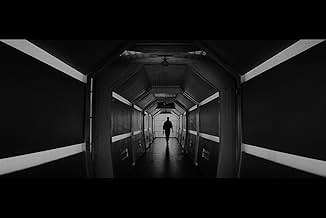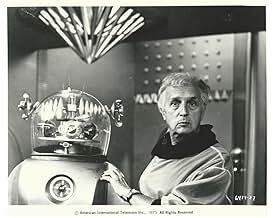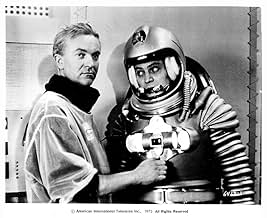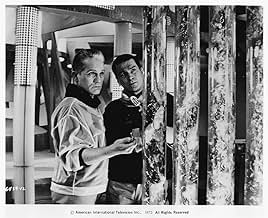Ikarie XB 1
- 1963
- Tous publics
- 1h 26m
IMDb RATING
6.9/10
3.2K
YOUR RATING
The year is 2163. Starship Ikarie XB 1 embarks on a long journey across the universe to search for life on the planets of Alpha Centauri.The year is 2163. Starship Ikarie XB 1 embarks on a long journey across the universe to search for life on the planets of Alpha Centauri.The year is 2163. Starship Ikarie XB 1 embarks on a long journey across the universe to search for life on the planets of Alpha Centauri.
- Awards
- 1 win total
Featured reviews
Still relatively unfamiliar to western audiences, Ikarie XB 1 is an example of east European science fiction cinema on a fairly ambitious scale deserving of wider appreciation. Usually it's been only seen in a butchered edition created Stateside - duly shorn of a plot strand, dubbed with a different ending, with a dumb title.
With the benefit of hindsight, a lot of the original seems familiar. With its clean interior ship design, crew neck uniforms all round, glide doors, shiny deck flooring as well as a 15-year mission to seek out new life, Ikarie may have given later pause for thought for a certain Gene Roddenberry. Genre fans will also note that, during the first big set piece, the crew are startled by an unexpected alarm and deviate from their mission to investigate a derelict spacecraft - events which end with a nuclear detonation in space. Add to this the changes wrought by the American bastardisation of Voyage To The End Of The Universe, that included an ending which anticipates Planet of the Apes, as well as its possible inspiration to Kubrick when planning 2001, and Ikarie certainly offers much of interest. Not to mention its own borrowings eg Ikarie's robot Patrick, inspired by Forbidden Planet (1956)
Polák's was also responsible for an intriguing Nazi time travelling movie, with a small cult on its own account, Tomorrow I'll Wake Up And Scald Myself With Tea, made in the late 1970s. Less idiosyncratic than this, one imagines, Ikarie is much more serious in tone, set mostly aboard a roomy spacecraft, crewed by 40, dispatched to discover if there is any life on Alpha Centauri. A feeling of worthwhile isolation permeates this journey, with none of the trivial, trials and stresses one expects from space dramas made closer to home at this time, where mad scientists lurk, robots lumber threateningly or spacewomen defer to their mates. Missing too is the pseudo technical claptrap which lumbers much American SF, then or now. Ikarie's hardware exists mainly in the background, without need of explanation. The film expects us to take its conspicuous 22nd century advances just as seen, being concerned more with sociology than technology.
Ikarie features a harmonious society in miniature, shown in a series of interactions aboard, even down to the calm acceptance of on board pregnancy - an adult theme incidentally completely excised in the American version. In such an hospitable environment, even the mad can be talked round without violence, as in the case of Michael (Otto Lackovic) who, affected by radiation and in a disastrous manoeuvre, wants to turn the ship back to Earth. That the only real threat the crew face is an external one is significant, and also primes the dramatic moment that begins the narrative. A flash-forward to when (infected by the same source, as we learn later), one of the crew is wandering, bewildered and aggressive, through the ship. "Earth is gone," he says. "Earth never existed." But he's not beyond help from his peers. Here the deluded or mad in space are not assumed lost, such as we might see in such recent American films as Event Horizon, but taken back and with promise of cure at that.
Critics have contrasted these shipboard mores to the signs of capitalist degeneracy confronting those who board the 'Tornado', the derelict space station from 1987 unexpectedly encountered en route. Here, amidst the dark clutter of its interior, are found signs of gambling and money, coded elements of capitalist speculation, just as fatal as the death gas and nuclear warheads also there. For those who explore it, the Tornado reflects a place thought left behind, both geographically and politically. "We have discovered the 20th century," says one dismayed crewman. The determined self destruction encountered by those who board the derelict recalls one of TV's original Star Trek shows, and those found died as result of a selfish fight for survival. The signs of a corrupt political system fall exposed with as much horror as does (in a notable moment) the skin off the Tornado captain's face.
This, and then the debilitating effects of rays that emanate from a hitherto unknown black star are the two principal threats facing the crew. How they finally overcome this last hurdle is part of the end of the quest. Without giving too much away, it is sufficient to say that the close of the film, the ship's long anticipated arrival at Alpha Centauri's 'white planet', brings a sequence both uplifting and brief, carrying over the theme of mutually beneficial cooperation. But viewers today may find less interest in the ending than the scenes that have preceded it. It's the Ikarie crew's social or dutiful pairings, even to the point of bringing each other flowers, or taking showers together, which lay at the heart of the film, rather than any encounter of a new civilisation and the socialist message entailed. Whilst in basic narrative terms the 'white planet' brings closure, our attentions have for long been focused elsewhere, in scenes such as the notable dance sequence. Through the hypnotic rhythms of Zdenek Liska's striking score, the astronauts take part in something akin to a weird 22nd century disco, their slow somnambulistic movements reassuring while also slightly disturbing. Reassuring, as we can see the crew reacting together as one social unit, even after the inevitable trials of months in space; disturbing because it is all so emotionless and controlled. Such ambiguous group occasions beg questions we really want answered. Are they really happy? Or does the Earth we thought we recognised in them no longer exist?
The Czech originated disc I have seen offers a splendid widescreen transfer of the movie with English subtitles. Most of the extras are unfortunately not subtitled, but there's a chance to see some sample scenes from the American International version, to give an idea of how the original was changed as well as a stills gallery.
With the benefit of hindsight, a lot of the original seems familiar. With its clean interior ship design, crew neck uniforms all round, glide doors, shiny deck flooring as well as a 15-year mission to seek out new life, Ikarie may have given later pause for thought for a certain Gene Roddenberry. Genre fans will also note that, during the first big set piece, the crew are startled by an unexpected alarm and deviate from their mission to investigate a derelict spacecraft - events which end with a nuclear detonation in space. Add to this the changes wrought by the American bastardisation of Voyage To The End Of The Universe, that included an ending which anticipates Planet of the Apes, as well as its possible inspiration to Kubrick when planning 2001, and Ikarie certainly offers much of interest. Not to mention its own borrowings eg Ikarie's robot Patrick, inspired by Forbidden Planet (1956)
Polák's was also responsible for an intriguing Nazi time travelling movie, with a small cult on its own account, Tomorrow I'll Wake Up And Scald Myself With Tea, made in the late 1970s. Less idiosyncratic than this, one imagines, Ikarie is much more serious in tone, set mostly aboard a roomy spacecraft, crewed by 40, dispatched to discover if there is any life on Alpha Centauri. A feeling of worthwhile isolation permeates this journey, with none of the trivial, trials and stresses one expects from space dramas made closer to home at this time, where mad scientists lurk, robots lumber threateningly or spacewomen defer to their mates. Missing too is the pseudo technical claptrap which lumbers much American SF, then or now. Ikarie's hardware exists mainly in the background, without need of explanation. The film expects us to take its conspicuous 22nd century advances just as seen, being concerned more with sociology than technology.
Ikarie features a harmonious society in miniature, shown in a series of interactions aboard, even down to the calm acceptance of on board pregnancy - an adult theme incidentally completely excised in the American version. In such an hospitable environment, even the mad can be talked round without violence, as in the case of Michael (Otto Lackovic) who, affected by radiation and in a disastrous manoeuvre, wants to turn the ship back to Earth. That the only real threat the crew face is an external one is significant, and also primes the dramatic moment that begins the narrative. A flash-forward to when (infected by the same source, as we learn later), one of the crew is wandering, bewildered and aggressive, through the ship. "Earth is gone," he says. "Earth never existed." But he's not beyond help from his peers. Here the deluded or mad in space are not assumed lost, such as we might see in such recent American films as Event Horizon, but taken back and with promise of cure at that.
Critics have contrasted these shipboard mores to the signs of capitalist degeneracy confronting those who board the 'Tornado', the derelict space station from 1987 unexpectedly encountered en route. Here, amidst the dark clutter of its interior, are found signs of gambling and money, coded elements of capitalist speculation, just as fatal as the death gas and nuclear warheads also there. For those who explore it, the Tornado reflects a place thought left behind, both geographically and politically. "We have discovered the 20th century," says one dismayed crewman. The determined self destruction encountered by those who board the derelict recalls one of TV's original Star Trek shows, and those found died as result of a selfish fight for survival. The signs of a corrupt political system fall exposed with as much horror as does (in a notable moment) the skin off the Tornado captain's face.
This, and then the debilitating effects of rays that emanate from a hitherto unknown black star are the two principal threats facing the crew. How they finally overcome this last hurdle is part of the end of the quest. Without giving too much away, it is sufficient to say that the close of the film, the ship's long anticipated arrival at Alpha Centauri's 'white planet', brings a sequence both uplifting and brief, carrying over the theme of mutually beneficial cooperation. But viewers today may find less interest in the ending than the scenes that have preceded it. It's the Ikarie crew's social or dutiful pairings, even to the point of bringing each other flowers, or taking showers together, which lay at the heart of the film, rather than any encounter of a new civilisation and the socialist message entailed. Whilst in basic narrative terms the 'white planet' brings closure, our attentions have for long been focused elsewhere, in scenes such as the notable dance sequence. Through the hypnotic rhythms of Zdenek Liska's striking score, the astronauts take part in something akin to a weird 22nd century disco, their slow somnambulistic movements reassuring while also slightly disturbing. Reassuring, as we can see the crew reacting together as one social unit, even after the inevitable trials of months in space; disturbing because it is all so emotionless and controlled. Such ambiguous group occasions beg questions we really want answered. Are they really happy? Or does the Earth we thought we recognised in them no longer exist?
The Czech originated disc I have seen offers a splendid widescreen transfer of the movie with English subtitles. Most of the extras are unfortunately not subtitled, but there's a chance to see some sample scenes from the American International version, to give an idea of how the original was changed as well as a stills gallery.
This is for sf-film completists. It seems to fill a gap between the late-50's style of sf movie and the forever-after effects of Star Trek and Kubrick's "2001." The only version you're likely to see is the American International release. The Encyclopedia of SF says the original film is in color, but AI's print is B&W, probably to save costs on the number of prints they may have made from a film I suspect they got for little money in the first place.
The story is about a big "community" sized spaceship making a long journey to "the green planet." Another reviewer said the ship was faster than light, but a couple of references to time-dilation effects in the dialog make it more likely that the ship was a near-lightspeed model. This has an influence on the spooky atmosphere that pervades the whole film, making the crew/community highly insular, as they realize they are cut off completely from the lives they have left behind.
The sfx are slightly better than Dr. Who episodes of similar vintage, with a couple of really good spacesuits and an unusual design for the ship itself. There's also a very, very neat shot of the ship in orbit around its destination that is a dead ringer for a similar moment in "Alien," and quite effective (in both films), in a way that most movies about spaceships seem to forego.
Still, the story rambles and seems kind of shallow. The sets and sfx aren't bad, but don't make up for the weak script. I recommend this for true lovers of the form (as I am), because you just wouldn't want to be left wondering what might have been going on in sf films, even east European ones, in the early '60s. Here's your answer.
The story is about a big "community" sized spaceship making a long journey to "the green planet." Another reviewer said the ship was faster than light, but a couple of references to time-dilation effects in the dialog make it more likely that the ship was a near-lightspeed model. This has an influence on the spooky atmosphere that pervades the whole film, making the crew/community highly insular, as they realize they are cut off completely from the lives they have left behind.
The sfx are slightly better than Dr. Who episodes of similar vintage, with a couple of really good spacesuits and an unusual design for the ship itself. There's also a very, very neat shot of the ship in orbit around its destination that is a dead ringer for a similar moment in "Alien," and quite effective (in both films), in a way that most movies about spaceships seem to forego.
Still, the story rambles and seems kind of shallow. The sets and sfx aren't bad, but don't make up for the weak script. I recommend this for true lovers of the form (as I am), because you just wouldn't want to be left wondering what might have been going on in sf films, even east European ones, in the early '60s. Here's your answer.
Written by the same man who wrote Solaris, rather than a science fantasy, space opera, or race movie like many other scifi films of that era (many of which are just as excellent in their own way - see The Sky Calls, Planeta Bur, or Forbidden Planet, for example), Ikarie XB1 (aka Journey to the End of the Universe) is a serious-minded science fiction drama, with element of mystery and suspense.
My rating of 9 out of 10 Stars might be a little exuberant, but that was my reaction to the film. The sets are sumptuous, almost art deco, the black and white cinematography crisp and beautiful to look at, and the acting always competent or better. The score is largely electronic, with some distorted electric guitar, and no orchestral elements.
Ikarie XB1 is so different from a lot of other science fiction cinema being produced at the time that I found it to be a captivating surprise.
My rating of 9 out of 10 Stars might be a little exuberant, but that was my reaction to the film. The sets are sumptuous, almost art deco, the black and white cinematography crisp and beautiful to look at, and the acting always competent or better. The score is largely electronic, with some distorted electric guitar, and no orchestral elements.
Ikarie XB1 is so different from a lot of other science fiction cinema being produced at the time that I found it to be a captivating surprise.
This czech scifi made in 1963 is surprisingly fresh compared to most films within the scifi genre.
The story of a multinational crew heading to unknown planet and along its path has to deal with many dangerous situations, has to be one of the most used story lines in scifi.
Even though we've seen so many times this film uses a very lowkey, socialrealistic approach. More reminiscent of latter efforts like Alien (1979), Silent Running (1972), Outland (1981).
This film portrays the crew and its members, struggling with everyday problems. Like childbirth, parties, relationships in space etc.
There is also the fact that this film was made during communist rule in Czechoslovakia which might explain the lack of glamorous, action filled scenes. In fact the films hints that decadent, capitalistic society is doomed to fail.
But there is also hints that the communistic state might contain flaws as well.
Todays audience might be disapproving against the sometimes slow, socialrealistic tone/style of the film but I for one found it quite refreshing.
Well-made scifi films without action, ridiculous high tempo, is hard to come by, and I hope more people will see this film.
The story of a multinational crew heading to unknown planet and along its path has to deal with many dangerous situations, has to be one of the most used story lines in scifi.
Even though we've seen so many times this film uses a very lowkey, socialrealistic approach. More reminiscent of latter efforts like Alien (1979), Silent Running (1972), Outland (1981).
This film portrays the crew and its members, struggling with everyday problems. Like childbirth, parties, relationships in space etc.
There is also the fact that this film was made during communist rule in Czechoslovakia which might explain the lack of glamorous, action filled scenes. In fact the films hints that decadent, capitalistic society is doomed to fail.
But there is also hints that the communistic state might contain flaws as well.
Todays audience might be disapproving against the sometimes slow, socialrealistic tone/style of the film but I for one found it quite refreshing.
Well-made scifi films without action, ridiculous high tempo, is hard to come by, and I hope more people will see this film.
I just saw a gorgeous, widescreen, subtitled print of "Ikarie XB 1", also known as "Voyage To The End of the Universe", at Boston's Museum of Fine Arts. The print, restored by the Czech studio that originally released it, is in black and white, and was obviously shot that way. Its complete running time is listed in the program notes as 84 minutes, though it may have been a few minutes longer. (I should have checked my watch). Like several others who've commented on this, I first saw this movie as a kid when AIP released a dubbed version in the 60s. Its definitely not a kiddie movie, and is still quite impressive for its effects and production design, as well as its intelligent story.
Did you know
- TriviaThe music played on piano after the derelict ship explodes is "Part One: Introduction" from "King David", aka "Le Roi David," composed by Arthur Honegger.
- Alternate versionsSPOILER: For the American release, titled "Voyage to the End of the Universe," American International Pictures cut the film up, changing a number of things:
- Approximately 26 minutes of footage were removed (including a sequence in a man-made flying saucer carrying dead capitalists, nerve gas and an atomic bomb).
- The story was changed substantially, the ship's flight direction reversed (making it an alien ship traveling to Earth), and the Statue of Liberty pasted into the final shot.
- The cast and staff's names in the credits were altered significantly to look like English.
- How long is Voyage to the End of the Universe?Powered by Alexa
Details
Box office
- Gross worldwide
- $2,130
- Runtime1 hour 26 minutes
- Color
- Sound mix
- Aspect ratio
- 2.35 : 1
Contribute to this page
Suggest an edit or add missing content

































